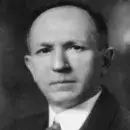
Alfred James Lotka
Alfred James Lotka was a mathematician, physical chemist, and biostatistician, famous for his work in population dynamics and demography. Born in Lviv (then part of Austria-Hungary; now Ukraine) to American Jewish parents, Lotka was educated at the University of Birmingham in the United Kingdom (B.Sc., in physics and chemistry, 1901; D.Sc., 1912), Leipzig University’s Physical-Chemical Institute in Germany (1901–1902), and Cornell University (M.A., physics, 1909). He worked as an assistant chemist at the General Chemical Company (1902–1908, 1914–1919), a patent examiner at the U.S. Patent Office (1909), assistant physicist at the National Bureau of Standards (1909–1911), editor of the Scientific American Supplement (1911–1914), resident at Johns Hopkins University (1922–1924), and statistician for the Metropolitan Life Insurance Company in New York City (1924–1948).
Considered one of the founders of mathematical demography, Lotka pioneered models and equations that continue to play a vital role in population studies. His most influential contribution was the demographic theory of stable populations–a model in which birth and death rates remain constant–which opened significant new areas of research into population growth and decline. Lotka is also credited with developing the predator-prey model (though it is co-credited to Vito Volterra, who developed it independently), which became foundational in ecological population dynamics.
Beyond demography, he evaluated the lifetime economic value of workers by age, modeled the spread of infectious diseases such as malaria, and introduced Lotka’s Law, a measure of the distribution of scientific productivity. With Louis Israel Dublin, another statistician at Metropolitan Life, he coauthored three books on demography and public health: The Money Value of a Man (1930), Length of Life (1936), and Twenty-Five Years of Health Progress (1937). His most influential work, Elements of Physical Biology (1925), explored “growth and reproduction of organisms, equilibrium between organisms and their environment, evolutionary change, energy balance, the operations of the senses, and the problem of consciousness.” His book Theorie Analytique des Associations Biologiques, published in two parts in 1934 and 1939, summarized the essentials of his work on the mathematical theory of evolution and on the mathematics of population analysis.
Lotka served as president of the Population Association of America (1938–1939) and of the American Statistical Association (1942), and in several posts at the International Union for the Scientific Study of Population, including as vice president (1948–1949).